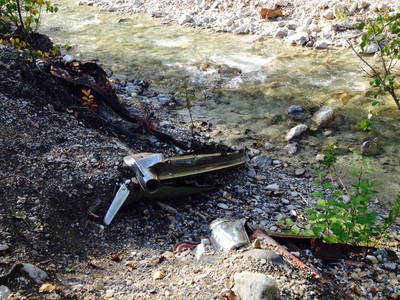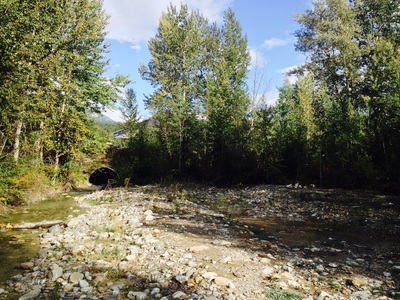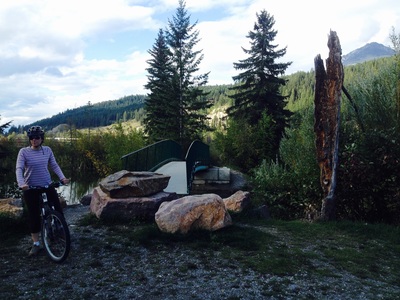Other Areas
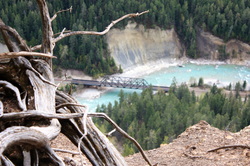
While the main thrust (and scope) of this project is riverfront activities, it is important to understand that there are other areas that can positively impact the quality of life and economic development potential of Golden & Area A residents.
This non-exhaustive list of other areas includes:
While there may be other areas, it is prudent to start from the center of Golden and work outward as resources allow.
This non-exhaustive list of other areas includes:
- Highway #95 Cloverleaf
- Hospital Creek
- South Golden
- Golden Donald Upper Road & the BCVC @ Golden
- Trailhead Development Outside Town Limits
- Hiking Trail Development
- Canadian Pacific Railway's Edelweiss Village
- Burges & James Gadsden Provincial Park
While there may be other areas, it is prudent to start from the center of Golden and work outward as resources allow.
Highway #95 Cloverleaf

An often overlooked green space, the Highway #95 Clover Leaf is managed (and in the summer, manicured) by the Ministry of Transportation. This multi-acre site does not have any designated uses, but could lend itself to more active uses, should other, more available sites become occupied.
Possible uses, provided there is adequate infrastructure (like fencing), include:
Possible uses, provided there is adequate infrastructure (like fencing), include:
- Dog park
- Disc golf
- Parking
Hospital Creek
Hospital Creek runs through the Husky Trailer Park, under the Trans Canada Highway, the Chevron gas station, the back yard of The Sportsman, before crossing another road and through the Brookside Motel. While the upper part, above the Trailer Park is explored as a short hike with a waterfall payoff, the lower section is relatively undiscovered.
The lower section provides visible evidence of how diking was done in Golden in the 1970s. Here one can see many crushed cars forming part of the dike walls on the south side of the river. There were also 50 gallon barrels visible to the east. Someone has installed a picnic table and there is evidence of small fire pits, well hidden from outside viewers.
And although not encouraged, one can probably walk (with wet feet) through the large culvert underneath the TCH.
What is the potential here? Who knows. It would be important to find out who has control/ownership first. And then, if a priority, determine if environmental remediation is required.
The lower section provides visible evidence of how diking was done in Golden in the 1970s. Here one can see many crushed cars forming part of the dike walls on the south side of the river. There were also 50 gallon barrels visible to the east. Someone has installed a picnic table and there is evidence of small fire pits, well hidden from outside viewers.
And although not encouraged, one can probably walk (with wet feet) through the large culvert underneath the TCH.
What is the potential here? Who knows. It would be important to find out who has control/ownership first. And then, if a priority, determine if environmental remediation is required.
Edelweiss Slough
A hidden gem of a green space be found just north of the Tim Horton's and RCMP station. Edelweiss Slough is a small park with a new bridge. The trail which leads to Anderson Road was a one point in the past the old Big Bend Highway.
Currently, rocks protecting either end make cycle access difficult. The trail is overgrown, and besides being very low on the south 150m (level with the water), it has a 1'x2' ditch mid-way.
While this is just off the TCH and a tranquil place for picnics, there are no signs, picnic tables, benches or anything that suggests this is a rec area. The gravel cul de sac at the south access has a bear proof garbage bin.
Currently, rocks protecting either end make cycle access difficult. The trail is overgrown, and besides being very low on the south 150m (level with the water), it has a 1'x2' ditch mid-way.
While this is just off the TCH and a tranquil place for picnics, there are no signs, picnic tables, benches or anything that suggests this is a rec area. The gravel cul de sac at the south access has a bear proof garbage bin.
South Golden
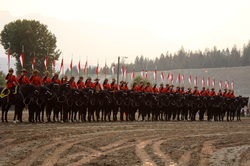
The south end of Golden is rather undeveloped and the existing terrain and facilities may fit a number of possible activities.
- Reflection Lake
- Gravel Pit - possible amphitheater, overflow camping, light industrial land.
- Nicholson Pedestrian/Cycling Trail - although not likely with the 2012 widening of Highway #95
- Rodeo Grounds
- Dog Agility Field
- Motocross Track
|
Highway #95 road improvements could include removing the old bridge over the CPRail yard and realigning the road. A proper pedestrian crossing area could be developed between Home Hardware and the BC Hydro building to keep pedestrians safe and reduce the speed of vehicles coming into town.
The front of Home Hardware could eventually become a museum exhibit, showcasing farming, logging or rail cars/equipment - and could even host the old rail station, if it was partially supported by CPRail and/or it's employees. Anyone interested in this concept should contact Doug Birnie, at Home Hardware. |
BC Visitor Centre @ Golden
This LEED-standard-built building was a project of Golden Area Initiatives (GAI) and has been home to the BC Visitor Centre @ Golden since 2006. Unfortunately, Destination BC (formerly Tourism BC) will be eliminating their contract for visitor centre services with Kicking Horse Mountain Resort at the end of 2015. With GAI closed, too, there will be no tenants in the building, which only used $150,000 in local taxpayer funds, from both local and regional government (the balance for the $2,300,000 building was secured through grants) and it is currently assessed at $930,000).
The directors of GAI (formerly Golden and Area Community Economic Development Society, or GACEDS), who are the Town of Golden and CSRD, intend to divest themselves of this building as soon as possible. However, having the community meet to discuss and research what can be best done with the building may be worthwhile. Currently, GAI receives $81,000 in rent for the building, so whatever or whoever went in there would need to be cover the depreciation, plus operating expenses.
The Golden Museum has considered relocating to the TCH (at formerly Humpty's restaurant). Perhaps this would be a viable space? Perhaps this might be a good project to pull together all local arts, culture & heritage organizations into a cultural centre? There is arguably no better location to attract visitors coming in on the TCH.
While the Chamber of Commerce pays no annual rent to CPR for the use of the old railway station, perhaps it should move to replace the BCVC @ Golden services? Whatever is
Or following Squamish's Adventure Centre, perhaps a number of tourism activity providers and restaurants can share the space and costs? If GAI (GACEDS) would like to repurpose the building for anything other than a visitors centre, they will require the permission of the Province. And if they want to divest themselves of the building, GAI will need to obtain the land from the Province.
Stratafication of the building is a concept encouraged by Charles Hamilton, CSRD CAO. Ministry of Transportation, Kicking Horse Mountain Resort and the CSRD Electoral Area A may be possible tenants. This option may take more effort in managing and setting up, it may offer a lower risk to the community than having a 3rd party own the entire building. (While the building is owned by GAI (GACEDS), the society will need to remain solvent, at a cost of ~$6,000/year.)
While the roof has been problematic and costly to repair, selling the building in a slow commercial property market may not be prudent, especially considering that the proceeds from the sale will likely be split between the local and regional government and may end up in general revenues.
Also, should a private company buy this building and keep it vacant, it will become a blight on Golden's entrance experience.
The directors of GAI (formerly Golden and Area Community Economic Development Society, or GACEDS), who are the Town of Golden and CSRD, intend to divest themselves of this building as soon as possible. However, having the community meet to discuss and research what can be best done with the building may be worthwhile. Currently, GAI receives $81,000 in rent for the building, so whatever or whoever went in there would need to be cover the depreciation, plus operating expenses.
The Golden Museum has considered relocating to the TCH (at formerly Humpty's restaurant). Perhaps this would be a viable space? Perhaps this might be a good project to pull together all local arts, culture & heritage organizations into a cultural centre? There is arguably no better location to attract visitors coming in on the TCH.
While the Chamber of Commerce pays no annual rent to CPR for the use of the old railway station, perhaps it should move to replace the BCVC @ Golden services? Whatever is
Or following Squamish's Adventure Centre, perhaps a number of tourism activity providers and restaurants can share the space and costs? If GAI (GACEDS) would like to repurpose the building for anything other than a visitors centre, they will require the permission of the Province. And if they want to divest themselves of the building, GAI will need to obtain the land from the Province.
Stratafication of the building is a concept encouraged by Charles Hamilton, CSRD CAO. Ministry of Transportation, Kicking Horse Mountain Resort and the CSRD Electoral Area A may be possible tenants. This option may take more effort in managing and setting up, it may offer a lower risk to the community than having a 3rd party own the entire building. (While the building is owned by GAI (GACEDS), the society will need to remain solvent, at a cost of ~$6,000/year.)
While the roof has been problematic and costly to repair, selling the building in a slow commercial property market may not be prudent, especially considering that the proceeds from the sale will likely be split between the local and regional government and may end up in general revenues.
Also, should a private company buy this building and keep it vacant, it will become a blight on Golden's entrance experience.
| |||||||
Trailhead Development Outside Town Limits

Trails are great. But there is little point to having them (and no point to maintaining them) without adequate access.
Trailhead development is necessary to ensure that users (residents and tourists) can actually get to the trails they want to use. It is prudent when planning, approving, funding, or marketing trail development that the trailhead is included.
Golden & Area A offers world-class scenery, however, to access many of the trailheads is very difficult. Some require a 4-wheeldrive vehicle. Others are not signed properly or don't appear on maps. Others are overgrown. For some, it is the reality that Forest Service Roads (FSR) are not as active as they have been or the roads have been decommissioned. Once the forest industry moves out of a particular area, there is no support for road maintenance and it doesn't take long for the roads to become all but impassable.
The Town of Golden's Resort Municipality Infrastructure Fund has made some inroads in proximate trailhead development. However, much more will need to be done in order to capitalize on and protect the natural capital that surrounds us.
Trailhead development is necessary to ensure that users (residents and tourists) can actually get to the trails they want to use. It is prudent when planning, approving, funding, or marketing trail development that the trailhead is included.
Golden & Area A offers world-class scenery, however, to access many of the trailheads is very difficult. Some require a 4-wheeldrive vehicle. Others are not signed properly or don't appear on maps. Others are overgrown. For some, it is the reality that Forest Service Roads (FSR) are not as active as they have been or the roads have been decommissioned. Once the forest industry moves out of a particular area, there is no support for road maintenance and it doesn't take long for the roads to become all but impassable.
The Town of Golden's Resort Municipality Infrastructure Fund has made some inroads in proximate trailhead development. However, much more will need to be done in order to capitalize on and protect the natural capital that surrounds us.
Hiking Trail Development

Hiking trails bring millions of visitors, and their wallets, to the Rocky Mountains each year. Although Golden does not have an official hiking club, there is Kevin Finnegan and his www.goldenhikes.ca website.
During an interview with Kevin in 2011, there were a number of different trail issues identified.
Hiking Trail Issues
In Town Trails (‘Green’ or easy)
Edelweiss Trail (great for bird watching)
– starts with a bridge to nowhere; has been underwater this year, but is considered an official road
Rotary Trails (10km)
– a great ‘hub’ to support ‘spoke’ trails (Edelweiss, Golden-Nicholson, Moonraker, Golden-Golf Course, etc.) and promote active transportation and hiking; currently receiving more signage and are featured on the Tourism Golden Cycling Map
Confluence Park Trail (great for heron watching and the Columbia River)
– a disconnected component of the Rotary Trails; the only in-town trail with a remote feel
Area A Trails (‘Blue’/moderate to ‘Black’/challenging)
Gorman Lake
– the gem of Kicking Horse Country; poor access; maintenance responsibility is uncertain and not up to an internationally-marketable standard; needs $5,000 worth of grader work on the top 4km of the FSR and signage
Mummery
– trailhead is pushed 4km back due to FSR washout
Mount 7
– not many trails, but FSR access to summit (paraglider take-off & ‘7’) and connected to paragliders and downhill mountain biker user groups; while the FSR has been improved, it still limits access
Frenchman’s Ridge & Table Mountain
– great road access, challenging vertical
Canyon Creek Trail
– very accessible, except for the very steep and rocky first 100m; is somewhat connected to KHMR & Eagles Eye restaurant; cross-purposed with cross country biking and horseback riding; a great snowshoe trail
Blaeberry River Trail
– from OB Campground over 2nd FSR bridge to Thompson Falls and back
Bugaboo Falls
– accessed from Spillimacheen/Brisco
Measurement
There has been no measurement of hiking activity and its impact on the community. One would expect there are considerably more hikers than bikers (10:1), but we don’t know. What is the impact in a visiting hiker on the local community? What is the impact of a local resident leaving Golden to hike in the National Parks? Perhaps lessons from the Tourism Golden’s biking study can be adapted for hiking trail development and management.
Future Project Selection
Although we both don’t know where to start, I have attached a report titled, “Pedestrian and Bicycle Infrastructure: A national study of employment impacts,” which can be one of the guiding documents for future hiking product and project selection. While the document is focused on more urban projects, there is a language and methodology that can be used in Golden. In concert with funding programs like Pioneer has accessed in the past, these principles may help us get the most bang for our dollar and volunteers’ time, creating sustainable trails.
GoldenHikes.ca
While Mr. Finnegan has no plans for any changes at this point, he is open to offers. Because trails in our area are not part of the National Parks, the maintenance of local trails is usually done by anonymous volunteers and catastrophic events often result in sections being closed for extended periods of time. This variability in trail conditions requires regular updating of the Golden Hikes website. If a private enterprise did this same work, it would cost a lot of money to 1) develop the initial database, 2) make regular visits and reports and 3) drive new visitors to the website.
Other Trail Marketing Material
In 2011, Parks Canada developed new ‘Green, Blue & Black’ hiking map brochures. Tourism Golden has a branded winter and summer backcountry map with little trail detail. The cycling map is in its 2nd edition and uses Google Earth images.
Summary
Where do we go with this information? Who leads? Where can support come from? It is hoped that the community can use this summary when prioritizing future tourism, community economic development, active transportation and environmental initiatives.
During an interview with Kevin in 2011, there were a number of different trail issues identified.
Hiking Trail Issues
- Condition & maintenance
- Accessibility
- Communication & signage
In Town Trails (‘Green’ or easy)
Edelweiss Trail (great for bird watching)
– starts with a bridge to nowhere; has been underwater this year, but is considered an official road
Rotary Trails (10km)
– a great ‘hub’ to support ‘spoke’ trails (Edelweiss, Golden-Nicholson, Moonraker, Golden-Golf Course, etc.) and promote active transportation and hiking; currently receiving more signage and are featured on the Tourism Golden Cycling Map
Confluence Park Trail (great for heron watching and the Columbia River)
– a disconnected component of the Rotary Trails; the only in-town trail with a remote feel
Area A Trails (‘Blue’/moderate to ‘Black’/challenging)
Gorman Lake
– the gem of Kicking Horse Country; poor access; maintenance responsibility is uncertain and not up to an internationally-marketable standard; needs $5,000 worth of grader work on the top 4km of the FSR and signage
Mummery
– trailhead is pushed 4km back due to FSR washout
Mount 7
– not many trails, but FSR access to summit (paraglider take-off & ‘7’) and connected to paragliders and downhill mountain biker user groups; while the FSR has been improved, it still limits access
Frenchman’s Ridge & Table Mountain
– great road access, challenging vertical
Canyon Creek Trail
– very accessible, except for the very steep and rocky first 100m; is somewhat connected to KHMR & Eagles Eye restaurant; cross-purposed with cross country biking and horseback riding; a great snowshoe trail
Blaeberry River Trail
– from OB Campground over 2nd FSR bridge to Thompson Falls and back
Bugaboo Falls
– accessed from Spillimacheen/Brisco
Measurement
There has been no measurement of hiking activity and its impact on the community. One would expect there are considerably more hikers than bikers (10:1), but we don’t know. What is the impact in a visiting hiker on the local community? What is the impact of a local resident leaving Golden to hike in the National Parks? Perhaps lessons from the Tourism Golden’s biking study can be adapted for hiking trail development and management.
Future Project Selection
Although we both don’t know where to start, I have attached a report titled, “Pedestrian and Bicycle Infrastructure: A national study of employment impacts,” which can be one of the guiding documents for future hiking product and project selection. While the document is focused on more urban projects, there is a language and methodology that can be used in Golden. In concert with funding programs like Pioneer has accessed in the past, these principles may help us get the most bang for our dollar and volunteers’ time, creating sustainable trails.
GoldenHikes.ca
While Mr. Finnegan has no plans for any changes at this point, he is open to offers. Because trails in our area are not part of the National Parks, the maintenance of local trails is usually done by anonymous volunteers and catastrophic events often result in sections being closed for extended periods of time. This variability in trail conditions requires regular updating of the Golden Hikes website. If a private enterprise did this same work, it would cost a lot of money to 1) develop the initial database, 2) make regular visits and reports and 3) drive new visitors to the website.
Other Trail Marketing Material
In 2011, Parks Canada developed new ‘Green, Blue & Black’ hiking map brochures. Tourism Golden has a branded winter and summer backcountry map with little trail detail. The cycling map is in its 2nd edition and uses Google Earth images.
Summary
Where do we go with this information? Who leads? Where can support come from? It is hoped that the community can use this summary when prioritizing future tourism, community economic development, active transportation and environmental initiatives.
Community Murals

There are a number of different ways community murals can be created. The common themes for their creation include brainstorming, image making and individual drawing and painting. They can be done by individuals and hosted by an art gallery. Or they can be done by youth, with donated materials, and presented on school properties. Or they can be attacked by the entire community and create a theme of walled canvases across the entire town, as the Downtown Penticton Association has done with the Reimagine Art Festival.
The photo here depicts part of the Art Gallery of Golden's mural depicting adventurers and settlers to the area.
The photo here depicts part of the Art Gallery of Golden's mural depicting adventurers and settlers to the area.
Canadian Pacific Railway's Edelweiss Village
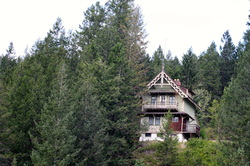
"A significant international mountain heritage has been remembered in a recent publication by the Swiss Consulate of Canada, "Swiss Guides, Shaping Mountain Culture in Western Canada." Edelweiss Village(six Swiss style chalets) was built in 1911 for the families of the second generation of Swiss Mountain Guides, who permanently emigrated to Canada in 1912. The Golden Era of Mountaineering in the Canadian Rockies was lead by Edward Feuz Jr., who guided over 100 first ascents in the Canadian Rockies. Ed's brothers Ernst and Walter also carried on the family mountain guiding traditions, of their father Edward Feuz Sr, and Christian Haesler Sr along with his son Christian Haesler Jr and Rudolph Aemmer.
A year long exhibit is currently on tour across Canada and is currently at the Golden Museum during summer 2010." - Irv Graham
A year long exhibit is currently on tour across Canada and is currently at the Golden Museum during summer 2010." - Irv Graham
Burges & James Gadsden Provincial Park

"Burges and James Gadsden, a pioneer couple of the Columbia Valley donated the original portion of the land for this provincial park to the people of the province of British Columbia in 1965 to be protected perpetually." - BC Parks, 2013
Approximately 11kms north of Golden, on the west side of the Trans Canada Highway, lies the 401 hectare Burges & James Gadsden Provincial Park, which "encompasses much of Moberly Marsh. This area, also a Ducks Unlimited Conservation project, protects the northern portion of the Columbia River Wetlands that stretch 185 km between Canal Flats and Golden." (BC Parks, 2013)
Across the road is the Berganham Conservation Area. Together, these properties represent a significant protected area, which currently have no facilities and little current signage.
Approximately 11kms north of Golden, on the west side of the Trans Canada Highway, lies the 401 hectare Burges & James Gadsden Provincial Park, which "encompasses much of Moberly Marsh. This area, also a Ducks Unlimited Conservation project, protects the northern portion of the Columbia River Wetlands that stretch 185 km between Canal Flats and Golden." (BC Parks, 2013)
Across the road is the Berganham Conservation Area. Together, these properties represent a significant protected area, which currently have no facilities and little current signage.
| gadsdenpurposestatementzoningplan.pdf | |
| File Size: | 500 kb |
| File Type: | |
Heron Rookery Viewpoint
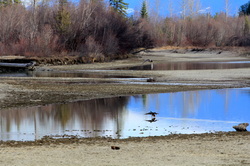
In 2008, the Columbia River Greenways Alliance proposed the installation of a flying balcony to view nesting herons 2.5km south of Golden. This project includes a highway pullout, viewing platform, educational signage, and spotting scope.
This proposal was cancelled in 2009 due to lack of funding for the $120,000 project.
This proposal was cancelled in 2009 due to lack of funding for the $120,000 project.
Community Forest
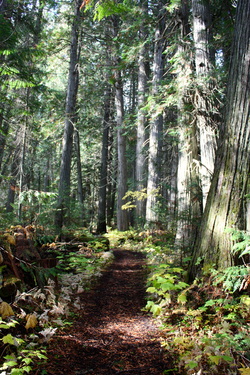
Community forests are another tactic for supporting more local control of forests and exist across BC. The establishment of a community forest in Golden was one concept that was mentioned at a few discussion tables during the September 8th, 2011 meeting.
Registered professional forester and leader of Healthy Forests-Healthy Communities, Mr. Bourgeois believes the community forest concept is “fundamentally sound. However, the government is not giving enough volume of wood to create viable and sustainable businesses. In the Interior, the minimum requirement is about 100,000m3 of Allowable Annual Cut (AAC). If a community gets less, say 30,000m3, the community can simply have some control over a small area regarding how it is managed, but it will be done by a contractor who has to have other logging opportunities to be viable and sustainable.”
If Golden was to apply for a community forest, Mr. Bourgeois would recommend applying for 100,000m3, which would be very challenging to arrange with the Province and require an innovative approach. Currently, Golden’s reserve has been cut substantially in the last year, down to 4,850m3, and all of the Golden Timber Supply Area’s AAC has been allocated to existing licensees and BC Timber Sales (BCTS) a part of the Ministry of Forests, Lands and Natural Resources Operations. If the government reallocates the allowable cut, then they would likely take from BCTS. There are other ways to package the increased request, like how the community works with BCTS, and this arrangement could reduce other pressures for support off the government’s shoulders.
A community forest, which had been explored a number of years ago, is not the only solution to building local control in forestry. This is one example of many mechanisms that communities can have influence on the forestry industry. But the first step is letting our community’s voices be heard and Thursday’s meeting started Golden in the right direction.
“Communities are no different than companies.” Mr. Bourgeois probes, “How does Golden become more self-sufficient?” A community forest provides revenue and jobs to become more self-sufficient and diversified. There are other opportunities such as tree farms, co-operatives, and value-added manufacturing businesses. Communities should maximize their internal resources and opportunities.”
"It’s time to start asking and defining ‘What is Golden’s vision for the local-regional forest?’" Bill Bourgeois suggests that once this has been identified and supported by the community, each one of the forestry companies, including BCTS, operating in the area should be invited to demonstrate to the public how they are contributing to this vision. "If they can’t show how, then they aren’t following sustainable forestry management principles.”
Registered professional forester and leader of Healthy Forests-Healthy Communities, Mr. Bourgeois believes the community forest concept is “fundamentally sound. However, the government is not giving enough volume of wood to create viable and sustainable businesses. In the Interior, the minimum requirement is about 100,000m3 of Allowable Annual Cut (AAC). If a community gets less, say 30,000m3, the community can simply have some control over a small area regarding how it is managed, but it will be done by a contractor who has to have other logging opportunities to be viable and sustainable.”
If Golden was to apply for a community forest, Mr. Bourgeois would recommend applying for 100,000m3, which would be very challenging to arrange with the Province and require an innovative approach. Currently, Golden’s reserve has been cut substantially in the last year, down to 4,850m3, and all of the Golden Timber Supply Area’s AAC has been allocated to existing licensees and BC Timber Sales (BCTS) a part of the Ministry of Forests, Lands and Natural Resources Operations. If the government reallocates the allowable cut, then they would likely take from BCTS. There are other ways to package the increased request, like how the community works with BCTS, and this arrangement could reduce other pressures for support off the government’s shoulders.
A community forest, which had been explored a number of years ago, is not the only solution to building local control in forestry. This is one example of many mechanisms that communities can have influence on the forestry industry. But the first step is letting our community’s voices be heard and Thursday’s meeting started Golden in the right direction.
“Communities are no different than companies.” Mr. Bourgeois probes, “How does Golden become more self-sufficient?” A community forest provides revenue and jobs to become more self-sufficient and diversified. There are other opportunities such as tree farms, co-operatives, and value-added manufacturing businesses. Communities should maximize their internal resources and opportunities.”
"It’s time to start asking and defining ‘What is Golden’s vision for the local-regional forest?’" Bill Bourgeois suggests that once this has been identified and supported by the community, each one of the forestry companies, including BCTS, operating in the area should be invited to demonstrate to the public how they are contributing to this vision. "If they can’t show how, then they aren’t following sustainable forestry management principles.”
| hfhc_golden_-_media_release_-_sep_13_2011.pdf | |
| File Size: | 241 kb |
| File Type: | |
Food Forest

A variation of a community forest is a food forest. The East Kootenay’s first demonstration food forest project was established at the Clear Sky Centre in Southeastern BC. Planted over 2012 and 2013, "this one acre demonstration food forest model will include a wide variety of nut trees, fruit trees, medicinals, berries, vines, shrubs, timber, mulch & shelter trees, all grown together in a holistic ecosystem based design. This project has received support through British Columbia Agroforestry Industry Development Initiative and aims to demonstrate a sustainable, permaculture based agroforestry system for food production in cold climates."
As well as raising environmental awareness, food forests are one step toward improving food security.
Golden has a number of locations that could be adapted into a food forest, including areas downtown (near hospital), near CPR land, on Selkirk Hill and the West Bench.
As well as raising environmental awareness, food forests are one step toward improving food security.
Golden has a number of locations that could be adapted into a food forest, including areas downtown (near hospital), near CPR land, on Selkirk Hill and the West Bench.
